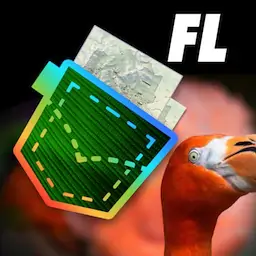Spanish Hole and ShipwreckHistory and Cultural Signs |
Spanish Hole and Shipwreck at St. Marks National Wildlife Refuge (NWR) in Florida. Published by the U.S. Fish & Wildlife Service (USFWS).
featured in
| Florida Pocket Maps |  |
30° 9.099' N
6
5
4
Mandalay: site of Aucilla River
St. Marks Lighthouse: site of
Lighthouse, Ft. Williams, and
Spanish Hole/Shipwreck
Mounds Station: site of
Paleo Mounds
Indians and
Shell
and Naval
Naval Stores
Stores
83° 58.769' W
83° 10.955'
58.769' W
84°
84° 9.869' W
St. Marks National Wildlife Refuge History Trail
Wakulla Beach: site of
Wakulla Beach Hotel and
West Goose Creek Seineyard
Seineyards
84°8.892' W
30° 7.797' N
30° 6.316' N
1
Plum Orchard: site of Port Leon
84°8.710' W
84°15.703' W
2
East River: site of CCC and
Salt Works
GPS Coordinates:
84° 10.955' W ~ 30° 4.658' N
3
GPS Coordinates:
84° 10.955' W ~ 30° 4.658' N
(Courtesy St. Marks Refuge files)
30° 6.985' N
30° 4.658' N
30° 5.282' N
Fort Williams, in a drawing from Frank Leslie’s
Illustrated Newpaper, February 22, 1862 (detail). (Courtesy State Archives of Florida)
When Spanish explorers first
searched the shallow waters of
Apalachee Bay they found few places
to anchor near shore, but in the mouth
of the St. Marks River they discovered
deeper water which has long been known
as Spanish Hole. For centuries, vessels
that could not navigate up the St. Marks
River have anchored there.
In 1528, Spaniard Panfilo de Narvaez
led 300 men across Florida from near
Tampa into Apalachee territory. Instead
of treasure, they found hardship. Legend
says that the expedition stayed near
the mouth of the St. Marks River long
enough to build four rafts to carry the
men to rejoin their ships. Eight years
later, four survivors arrived in Mexico.
Cabeza de Vaca, one of the survivors,
wrote about their ordeal in 1536 or 1537.
Hernando de Soto came with 600 men
in 1539, and followed nearly the same
route, believing that he could find the
This WWI sub chaser may be similar to the
ship that sank in 1928. (Courtesy St. Marks
Refuge files)
gold that had eluded Narvaez. He did
not.
The first wooden fort at San Marcos,
at the confluence of the Wakulla and
St. Marks Rivers, was built by the
Spanish Governor in 1679. Pirates
likely anchored at Spanish Hole and
crept upriver to loot and burn the fort
in 1681. A second wooden fort, built
in 1718, was replaced by a third fort
constructed in 1739 with limestone
from a quarry that is on refuge property.
This fort fell into disrepair.
When Florida was under British
control between 1763 and 1783, the
Panton - Leslie Company trading post
was established on the west side of
the Wakulla River, just north of U.S.
Highway 98. The Spanish regained
control of San Marcos by 1786.
Occupation has not been continuous,
but the area around the St. Marks and
Wakulla Rivers has seen settlements
come and go since the first Europeans
arrived more than four centuries ago.
Not far from Spanish Hole lie the remains of a small vessel which is visible
at low tide. In 1928, a ship anchored off
Long Bar, west of the lighthouse, caught
fire and burned, according to the late Alton Gresham. Gresham’s father, John Y.
Gresham, was the lighthouse keeper at
the time. The elder Gresham attempted
to tow the remains up the St. Marks River, but the boat ran aground and sank.
The vessel may have been the former
World War I sub chaser that had been
purchased by the Florida Shellfish Commission and renamed Dispatch. Under-
Small boats called “lighters” shuttled goods
and people between the ships at Spanish
Hole and the upriver ports of St. Marks,
Magnolia, Port Leon, and Newport. (Courtesy State Archives of Florida )
water archaeologists from Florida State
University studied the site in 1998 but
could not find conclusive evidence that
would identify the vessel as the sub
chaser.
The St. Marks Refuge Association, Inc.,
with a matching grant from the National Fish
and Wildlife Foundation, produced the signs
and brochures for the St. Marks National
Wildlife Refuge History Trail. The association
is a 501(c)(3) organization that supports
educational, environmental, and biological
programs of St. Marks National Wildlife
Refuge. Visit www.stmarksrefuge.org for more
information.
9/2010

